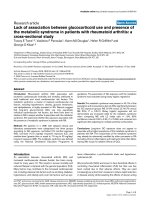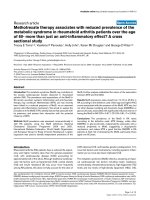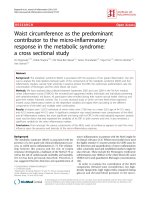metabolic syndrome pathophysiology
Bạn đang xem bản rút gọn của tài liệu. Xem và tải ngay bản đầy đủ của tài liệu tại đây (550.45 KB, 39 trang )
Metabolic Syndrome:
Pathophysiology
International Diabetes Center
What to call the syndrome?
•
•
•
•
•
•
Reaven’s Syndrome
Deadly Quartet
Insulin Resistance Syndrome
Syndrome X
Dysmetabolic Syndrome X
Multiple Metabolic Syndrome
• Metabolic Syndrome
International Diabetes Center
Clinical Identification
Metabolic Syndrome
Any Three of the Following:
Risk Factor
Defining Level
1. Abdominal obesity
Men
Women
Waist circumference
>40 in. (>102 cm)
>36 in. (90 cm)
>32 in. (80 cm)
>35 in. (>88 cm)
2. Triglycerides
≥150 mg/dL (1.7 mmol/L)
3. HDL-C
Men
Women
<40 mg/dL (1.0 mmol/L)
<50 mg/dL (1.3 mmol/L)
4. Blood pressure
≥130/85 mmHg
≥110 mg/dL (6.1 mmol/L)
5. Fasting glucoseCholesterol Education Program, Adult
National
Treatment Panel III. JAMA. 2001;285:2486.
International Diabetes Center
Prevalence(%)
50
45
40
35
30
25
20
15
10
5
0
Prevalence of the Metabolic
Syndrome Among US Adults
Men
Women
20-29
30-39
40-49
50-59
60-69
>70
Age (Years)
n=8814 men and women from the 3rd National Health
and Nutrition Examination Survey defined using NCEP ATP III Criteria
Ford et al. JAMA 2002; 287:356-359.
International Diabetes Center
Components of the Metabolic Syndrome
Hyperglycemia
Dyslipidemia
Hypertension
Insulin
Resistance
Abnormal
Thrombotic Risk
vascular behavior
Fat Mass
International Diabetes Center
Components of the Metabolic Syndrome
Hyperglycemia
Hyperglycemia
Dyslipidemia
Dyslipidemia
Hypertension
Hypertension
Insulin
Resistance
Abnormal
Abnormal
Thrombotic Risk
Thrombotic Risk
vascular behavior
vascular behavior
Fat Mass
Fat Mass
International Diabetes Center
Insulin Receptor
Insulin
α-subunit
Plasma Membrane
β-subunit
IRS-1
P
Tyr P
Tyr P
Tyr P
IRS-2
P
IRS-3
P
IRS = Insulin Receptor
Substrate
P = Phosphate group
Tyr = Tyrosine Kinase
Insulin Signaling Pathways Activated Affecting:
• Glucose, lipid and protein metabolism
• Cell division (mitosis)
International Diabetes Center
Potential Causes of Insulin Resistance
•Insulin Receptor Level
–Reduced tyrosine kinase activity
–Elevated phosphotyrosine phosphatase
•Post- Receptor Defects
–Reduced tyrosine phosphorylation of IRS1,
IRS2, IRS3
–Causes-likely many factors involved
•Free Fatty Acids
•Tumor Necrosis Factor-α
•Resistin???
White Mol Cell Biochem 1998; 182:3
International Diabetes Center
Role of FFA in Insulin Resistance
Adipose
Tissue
Free Fatty
Acids (FFA)
• Increase in adipocyte
number and size causes a
rise in FFA output
• High FFA concentration
decreases glucose uptake
and utilization in muscle and
liver
• Potential mechanisms:
– Increased accumulation of
triglyceride in liver and muscle
– Decreased glucose
transporter (Glut4) expression
International Diabetes Center
Obesity Induced Insulin Resistance: Role
of Tumor Necrosis Factor Alpha (TNF-α)
TNF-α Cytokine released from adipose tissue,
expressed at high levels in obese individuals
TNF-α
X
X
TNF-α
Adipose Tissue
Nucleus
TNF-α Receptor
Insulin Receptor
Glucose Transporter (GLUT 4)
Similar process may occur in fat and liver cells
GGG
GG
Muscle Cell
International Diabetes Center
Components of the Metabolic Syndrome
Hyperglycemia
Hyperglycemia
Dyslipidemia
Dyslipidemia
Hypertension
Hypertension
Insulin
Resistance
Abnormal
Abnormal
vascular behavior
Thrombotic Risk
Thrombotic Risk
Fat Mass
International Diabetes Center
Role of Obesity In Metabolic
Syndrome
• Central obesity is critical factor
– Waist to hip ratio >1
– Waist >40 inches in men
– Waist >35 inches in women
• Abdominal adipose tissue is more
metabolically active than
subcutaneous fat
• Increased release of FFA, TNFα leading to insulin resistance
FFA
TNF-α
Others
International Diabetes Center
It is not how much fat
you have, but where
you store it!!!
International Diabetes Center
Components of the Metabolic Syndrome
Hyperglycemia
Hypertension
Hypertension
Dyslipidemia
Dyslipidemia
Resistance
Abnormal
Abnormal
Thrombotic Risk
Thrombotic Risk
vascular behavior
vascular behavior
Fat Mass
International Diabetes Center
Prevalence of Metabolic Syndrome
(Percent Adults)
78-84%
(7 mmol/L)
(7 mmol/L)
(IFG)
(6.5 mmol/L)
(6.5 mmol/L)
Based on Fasting BG
(11.1 mmol/L)
(11.1 mmol/L)
42-64%
(IGT)
10-15%
(7.8 mmol/L)
(7.8 mmol/L)
Based on 2 hr. OGTT
Adapted from ADA and Isomaa et al. Diabetes Care 2001:24:683
10 to 15% of those with normal glycemia by fasting or OGTT have metabolic syndrome
International Diabetes Center
The Natural History of Glucose
Intolerance
Insulin Resistance and Insulin Deficiency
Insulin
Insulin
Resistance
Resistance
Relative
Relative
Insulin
Insulin
Deficiency
Deficiency
Pre-diabetes and
Pre-diabetes and
Type 2 Diabetes
Type 2 Diabetes
International Diabetes Center
Components of the Metabolic Syndrome
Hyperglycemia
Dyslipidemia
Hypertension
Hypertension
Resistance
Abnormal
Abnormal
Thrombotic Risk
Thrombotic Risk
vascular behavior
vascular behavior
Fat Mass
International Diabetes Center
Types of Lipoproteins
•Very Low Density Lipoprotein (VLDL)
–Produced in the liver
–Primary carriers of triglyceride
• Low Density Lipoprotein (LDL)
– Major carrier of cholesterol
– Diet high in saturated fat increases level
• High Density Lipoprotein (HDL)
– Function by returning cholesterol to liver
– Modest increase with exercise
International Diabetes Center
Dyslipidemia Associated with
Metabolic Syndrome
• Elevated Triglycerides
–
>150 mg/dL (1.7 mmol/L)
• Low Level of HDL
– <40 mg/dL (1.0 mmol/L) men
– <50 mg/dL (1.3 mmol/L) women
• Small dense LDL particles
International Diabetes Center
Increase in Triglycerides
Adipose Tissue
1. Increased fat stores result in breakdown
of triglyceride, released as FFA
FFA
2. Insulin resistance impedes
FFA uptake in adipose tissue
3. FFA taken up
by the liver
International Diabetes Center
Effect of FFA on Liver
High FFA leads to high VLDL,
a fatty liver, and high blood
triglycerides
Increased VLDL release
VLDL ParticlesCarrier of
Triglycerides
International Diabetes Center
Why low HDL in Metabolic Syndrome?
Hepatic
Lipase
P
CET
Large LDL
VLDL
(Triglyceride Rich)
Cholesterol
Triglyceride
Apo A1
Apo B100
Small Dense
LDL
Hepatic
Lipase
CET
P
HDL2
HDL3
CEPT = Cholesterol Ester
Transfer Protein
International Diabetes Center
Are all LDL particles the same?
LDL = 130 mg/dL in both examples
vs
Large “Fluffy” LDL
Less atherogenic
Small “Dense” LDL
More atherogenic
International Diabetes Center
Atherosclerosis
International Diabetes Center
Cellular Events Leading to
Atherosclerosis
BLOOD
Monocyte
adherence
HDL
LDL
ENDOTHELIUM
Foam cell
CE
LDL
Oxidation
CE
Macrophage
CE
Ox-LDL
CE
Activation
N
N
MATRIX
Smooth muscle cells
International Diabetes Center









